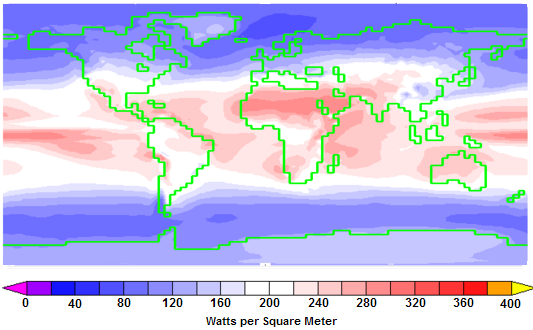
 |
Post Comments on my Blog |

 |
| The
Earth's orbit around the sun varies from nearly circular to elliptical
in a
90,000 to
100,000 year cycle. This can lead to a maximum 30% seasonal difference
in solar insolation when the orbit is at its most elliptical. At present the
eccentricity is relatively low (0.0174), and the Earth
receives 7% more solar energy in January (at perihelion, closest to the
sun)
than in July (at aphelion). The
orbit is gradually becoming more circular. The Earth's orbital velocity is faster when closest to the sun. The present northern winter (at periihelion) is four days longer than summer. |
 |
| Obliquity is a change in the
tilt of the Earth's axis, between 22.1 and 24.5 degrees, in a 41,000
year cycle. Because this
tilt
changes, the seasons as we know them can become exaggerated. More tilt
means more severe seasons. We are presently about half way through a
cycle (at 22.4 degrees), and the axial tilt is gradually drecreasing. A change in obliquity from 22 deg. to 24.5 degree increases annual average insolation at latitude 65 deg. by 5 W/m2, and at the poles by 17 W/m2, while insolation at the equator decreases by about 3.5 W/m2. [ref, #193] Obliquity acts in combination with eccentricity. A large tilt in combination with an eccentric orbit can lead to large changes in seasonal insolation, described below. |
 |
| Precession is a gradual change
in the
direction of the Earth's axis, caused
by gravitational torques exerted by the Moon and Sun on the
Earth in a 21,000 year cycle. This affects the time of year a
season will occur. Precession is
causing the (northern) winter solstice to come later every year, and in
10,500 years winter will occur in July. Precession affects whether the closest approach of the Earth's orbit to the sun occurs in northern summer or winter. Given the very different geography of the northern and southern hemispheres, this has a large effect on climate. Northern winters will gradually become cooler as winter occurs when the Earth is farther from the sun, and summers will become warmer. Since 1750 there has been a 0.4% increase in solar radiation (1.4 W/m2 ) in the northern hemisphere in April with a corresponding decrease in radiation in September [ref]. See this page for a detailed description of the effect of orbital cycles on season length. |




 |
Post Comments on my Blog |
